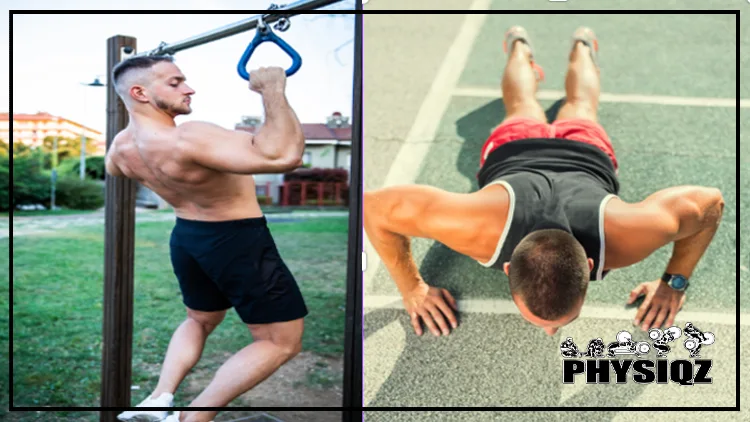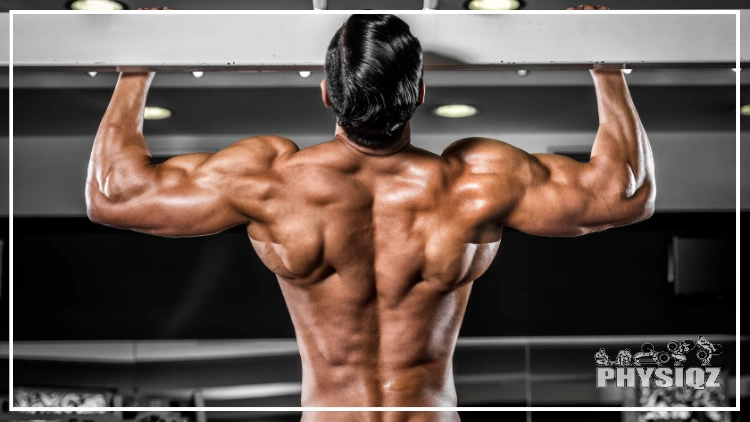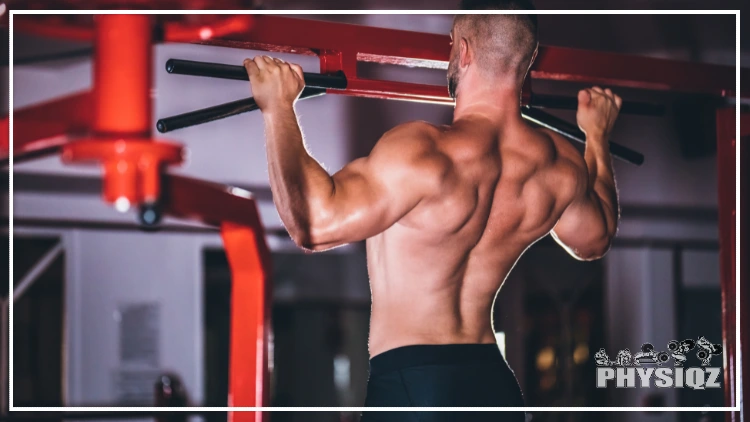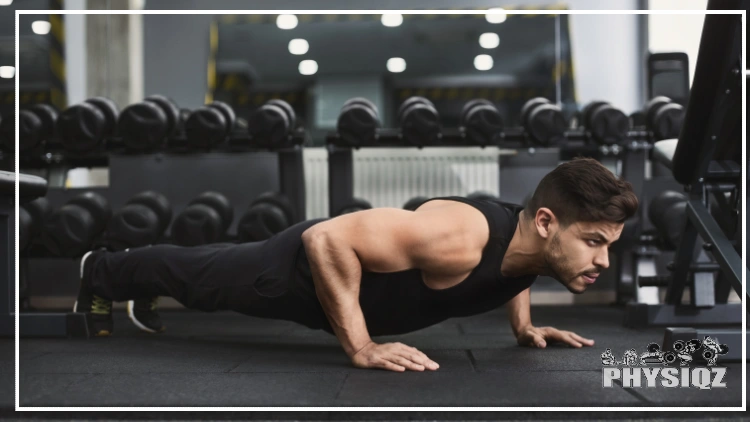
When comparing a pull up vs push up, it’s clear that they are distinct exercises targeting different muscle groups.1
Truth be told, they’re both extremely popular exercises that are beneficial, but pull ups are better because it’s an amazing hypertrophic compound exercise for the upper body, can easily be modified for weighted progression, pulling has more functional benefits than pushing, and has more hormonal benefits than push ups too.
That being said, there’s no doubt that both should be included in a workout routine so this article compares the two back-to-back in explores the muscles worked for each, how to do both with good form and other intricacies of each exercise.
The Advantages of Pull Ups & Their Targeted Muscles
A pull up is arguably the most powerful bodyweight exercise for building meaningful strength and maintaining quality of life. From the perspective of a body builder, it’s a highly effective way to reach muscles that aren’t always easy to hit. Pull ups are also one of the most cost-efficient exercises in the world.
While most gym equipment is expensive, a doorway-mounted pull up bar costs less than $20. Virtually any home or apartment will accommodate one of these pull up bars, and home gyms will be much better for having one. Doing pull ups might not be free in the way that doing push ups is, but it’s close enough.
The biceps are one of the two muscles that do the most work behind a pull up, but what’s more interesting is how much a pull up engages the lats. There are many ways to build strong biceps, but not much beats a pull up for strengthening the lats. Besides the lats, there are five other back muscles that the pull up engages. These are the traps, the rhomboids, and several other muscles that run alongside the spine.

Source: EXTREME-PHOTOGRAPHER via Canva.com2
If there’s any bodyweight exercise to incorporate into a workout routine that’s aiming for a strong, sculpted back and shoulders, it’s the pull up. However, the shoulder muscles and joints also get some excellent work in during a pull up. The shoulder is a highly complex joint, and it suffers heavily when a person lives a sedentary lifestyle. This is why pull ups can be a good way to prevent and relieve shoulder pain.
Every time a person does a pull up, it engages the majority of the shoulder and helps to maintain the strength and fluidity of the joint. This is where the strength gains that come with pull ups meet the health benefits. Strong shoulders and a strong back look great and drive greater performance, but they also sustain quality of life much more than other exercises.
A few of the muscles that the pull up works include the thoracic erector spinae, a group of three muscles that directly support the spine. Strengthening these muscles means a sturdier, healthier spine and makes it easy to maintain good posture when sitting. Gripping the pull-up bar during the exercise stimulates the muscles and joints of the hands more than a push-up.
This is another valuable way that pull ups extend day-to-day quality of life better than most exercises, whether bodyweight or weight-based.
Muscles Targeted by Pull-Ups
Virtually everything but the legs contributes when the body does a pull up with good form. Of course, these contributions aren’t equal. The primary muscles that gain from performing pull ups are in the arms, shoulders, and back. Besides these, though, there are secondary muscles that get a bit of a work out or at least get stimulated with every push up.
Primary Muscles Worked:
- Latissimus Dorsi
- Biceps
Secondary Muscles Worked:
- Triceps
- Trapezius
- Rhomboids
- Brachialis
- Pectoral muscles
- Abdominal muscles
- Teres minor
- Infraspinatus
- Thoracic erector spinae
- Deltoids
- Brachioradialis
Comparing Pull-Ups & Chin-Ups: Determining the Better Exercise
Sometimes people use pull up and chin up as interchangeable terms. There is a difference, though; the grip. When doing a chin up, their palms face toward them. On the other hand, a pull up uses a wider grip with palms facing away. Both grips provide excellent workouts that hit the entire upper body, but the difference is in the details.3
The chin up hits the biceps more than the lats, while pull ups are the other way around. The traps and lats are their main target, although they still work the biceps well. Pull ups also stimulate important stabilizer muscles deeper in the back more effectively than chin ups do. However, people often find pull ups much harder to do. While one study found that chin ups are more functional overall, pull ups emphasize some of the hardest muscles to grow.4
Every workout program is different, and the body thrives when it faces diverse challenges and unique types of stimulation. That’s why doing pull ups and chin ups as part of a workout program is the best way to get results, and why neither is superior to the other.
Proper Technique for Performing a Pull Up
The first step in doing a pull up is deciding what type of grip to use. There are two main options with a basic pull up bar:
- A wide grip with the palms facing away from the body (pull up)
- A narrow grip with palms facing toward the body (chin up)
Checking the grip comes first. With a chin up, the arms should be more or less directly above the shoulders. In comparison, hand placement for a pull up involves angling the arms slightly away from the shoulders. After this, the process is basically identical.

Source: urbazon via Canva.com5
After getting a secure grip, the next step is to pull upward with the arms and lift the chin to the bar. Angling the chin upward is a mistake, the neck should stay in the most relaxed, neutral position possible throughout the exercise. The hips should also remain in a neutral position.
Many people swing the hips upward so the momentum helps them complete the exercise, but this increases the risk of injury and makes the workout less effective.
After reaching this point, the next step a person takes is to lower themselves until their arms are fully extended. That equals one complete rep, and additional reps consist of going back up to chin-bar height and back down to the start position.
That’s how to complete a pull-up and understand its numerous benefits; now, let’s compare the push-up to it.
Advantages of Push Ups & the Muscles They Target
A pull up is a wonderful exercise, but there are some truly impressive benefits to push ups too. For one, men that can perform 40 push ups are more likely to be heart-healthy and live without adverse cardio events.6 On top of that, the only thing a person needs to do a pushup is their body.
Not only do pushups do a great job at activating the chest and tricep muscles, but for beginners, they’re just as good as a bench press at promoting muscle growth.7,8 Doing a high number of push ups can also be a solution to someone who’s concerned that they’re getting stronger but not bigger. Another perk to the push up is that it stimulates the core similarly to planking, which makes it a way of killing two birds with one stone.
Push ups are arguably the best strength training that a person can do with zero equipment. That’s a real advantage, even though good door-mounted pull up bars are cheap. Home pull up bars often aren’t suitable for travel, whereas anyone can perform a push-up based workout routine any time.
On top of that, push ups have the same bodyweight benefits that pull ups do. They’re low-impact compared to weights and a spotter isn’t necessary. This translates into a safer, more convenient exercise that a person can perform more frequently.
What Muscles Do Push Ups Work?
The muscles that the push up works mostly reside in the chest. However, the pushing motion also works the triceps and shoulders to a lesser extent. With proper form, the push up also enlists the support of the abs, lower back, and legs. While push ups don’t engage these muscles very much on their own, it’s beneficial to pair push ups with other exercises that do.
Primary Muscled Worked:
- Pectoralis muscles
- Deltoid muscles
- Triceps
Secondary Muscles Worked:
- Biceps
- Latissimus Dorsi
- Rhomboids
- Trapeze muscles
How To Perform a Push Up With Good Form
There are two key factors to correct form for pushups. The first factor is proper hand placement, while the second is a straight back. Hand placement helps target the right muscles and increase the difficulty of the exercise. On the other hand, keeping the back straight prevents injury and increases tension in the core and upper body.
A correct push up starts with the arms to either side of the torso and below the shoulders. Also, the legs should run straight downward, with the toes holding the body up. The next step is to push upward with great force, quickly moving the body upward. Throughout this process, the legs and back should remain straight.

Source: Prostock-studio via Shutterstock.com9
After fully extending the arms, the next step is to lower the body toward the ground. This should stop once the arms hit a 90 degree angle. This marks one repetition, and the exercise should continue with full extension, a return to a 90 degree angle, and a straigh back.
Leaving the knees on the ground or extending the arms away from the body are also ways to do a pushup. Either or both of these steps will result in easier pushups, with a much lighter load on the arms, chest, and core. It’s safe to do push ups in this way, but the exercise is much less effective. Despite that, it’s a valid way to get started if a person lacks the strength to do many standard pushups.
Back to Back Comparison of Pull Up vs Push Up
When comparing pull-ups and push-ups, it’s important to note that push-ups have advantages, like requiring no equipment and effectively targeting the chest. Both of the exercises moderately target the core, and in practice, the push up targets the core better than pull ups. Neither of them focus on the core, but a push up set includes more repetitions than a pull up set. However, the real purpose of both of these exercises is building upper body strength.
Push ups are much more effective at working the chest than pull ups, and they’re also good at working the triceps. However, pull ups hit a much wider variety of muscles. The biceps get a great workout from a pull up, as do muscles in the shoulders and back.
Changing the grip also means that the pull up will stimulate those muscles in different ways, which makes it more versatile. The fact that pull ups build grip strength while standard push ups don’t is another wrinkle in favor of the pull up.
Regardless of grip, pull ups target the arms more effectively than push ups. Pull ups also work the back and shoulders, which push ups don’t meaningfully impact at all. A beginner will find it easier to get started with push ups, but pull ups are more useful and meaningful in general.
Pull Up vs Push Up: Which Is Better? Why Pull Ups Are Better Than Push Ups?
Overall, pull ups outclass push ups in most areas. The two exercises are similar in that they’re low-impact, low-risk methods of working the upper-body and core with almost no equipment. Push ups have the small advantage of not needing any equipment at all. However, the pull up comes out on top with many advantages.
Comparing pull-ups and push-ups shows that a pull-up engages more muscles in a single movement, but muscle engagement isn’t the only factor to consider. For the most part, push ups work muscles that are easy to target whereas pull ups reach down into the shoulders and upper back. Not only are these muscles harder to reach, but they contribute to a strong back and healthy posture.
All in all, pull ups take the cake hands-down when it comes to their overall value for health and strength training but even though they win the pull up vs push up comparison, push ups have their in an exercise regimen too.
Frequently Asked Questions
How Many Pull Ups Are Recommended for Fitness Levels?
Four pull ups are the minimum target for a healthy, adult man. However, being able to do eight is a better goal that’s still realistic for the average person.
Is it safe to perform pull-ups and push-ups daily?
The jury is out on whether or not training every day is always harmful, or whether doing push ups every day is overtaining.5 Overall, it depends on intensity; pushing to exhaustion every day is harmful, but doing one pull up and a few push ups daily shouldn’t be problematic.
What is the recommended number of sit-ups to aim for?
A fit person should be able to do at least 10 sit-ups. According to a study from Japan, being able to do at least 10 sit ups helps prevent muscle loss as a person grows older.6
References
1Media Lens King. Canva. Accessed 15 April 2023. <https://www.canva.com/photos/MAEX44Z-tto-man-doing-pull-ups-outdoors/>
2EXTREME-PHOTOGRAPHER. Canva. Accessed 15 April 2023. <https://www.canva.com/photos/MAEJLC4M-xs-young-male-athlete-performing-pull-ups/>
3Avoiding high-risk rotator cuff loading: Muscle force during three pull-up techniques. (2020, November). NCBI. <https://pubmed.ncbi.nlm.nih.gov/32715526/>
4Kinematic and electromyographic comparisons between chin-ups and lat-pull down exercises. (2013). NCBI. <https://pubmed.ncbi.nlm.nih.gov/24245055/>
5urbazon. Canva. Accessed 15 April 2023. <https://www.canva.com/photos/MAEI-crHHZQ-strong-man-doing-pull-up-exercise/>
6Association Between Push-up Exercise Capacity and Future Cardiovascular Events Among Active Adult Men. (2019). NCBI. <https://www.ncbi.nlm.nih.gov/pmc/articles/PMC6484614/>
7Push-Ups vs. Bench Press Differences in Repetitions and Muscle Activation between Sexes. (2020, May). NCBI. <https://www.ncbi.nlm.nih.gov/pmc/articles/PMC7196742/>
8Low-load bench press and push-up induce similar muscle hypertrophy and strength gain. (2017, June). NCBI. <https://www.ncbi.nlm.nih.gov/pmc/articles/PMC7196742/>
9Prostock-studio. Shutterstock. Accessed 15 April 2023. <https://www.shutterstock.com/image-photo/strength-motivation-hispanic-man-doing-push-1221446191>